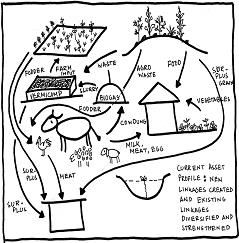Dulal Hansda, had a 4 bigha crop land (1 bigha = 1/3rd acre), 2 bullocks, 1 cow, 1 bigha of upland, 3 chickens, a space beside his homestead and a small pond as his asset. Bankura, where he lives, is a dry district with a moderately undulated terrain with high quantum of top-soil run off. Till 2011, from his 4 bigha of low land he was barely managing to produce 15 quintals of paddy (1 Q = 100 Kgs, from 100 kgs of paddy you get 70 kg of rice) in a year during rainy season only – for that he needed 1200 INR per bigha for chemical fertilizer. 1 bigha of the upland remained fallow permanently. Food produced in his entire farm could sustain him and his family only for 6~7 months, rest he had to manage by earning as wage labour.

He planned to start with his 1 bigha of upland which remained fallow so far, where, in the rainy season of 2012, he introduced soil-water conservation measures and planted local varieties of Roselle, Maize and Pigeon pea in rows and some leguminous vegetables in between.
With 3 cows, he had considerable amount of cow dung, which he was using occasionally only through farm yard manure or directly. He started doing high temperature heap and pit compost to get better quality manure by mixing with both dried and green crop waste along with chicken shit; and also introduce earthworms to produce vermicompost in a pit. In late 2012, he added biogas with subsidy support from the government. The biogas is now providing energy for cooking and helping in saving 300 kg of firewood per month (equivalent to INR 1800). And the slurry is used as vermin-feed. So the same amount of cow dung is now producing energy; it is also being used as vermifeed to produce vermicompost and finally being used as manure – this multiple usage is making the whole system more efficient and cost effective as he is getting maximum benefits out of it. Cow dung is also used as fish feed and for producing liquid manure by mixing with medicinal herbs and cow urine both as growth enhancer and pest repellent.
During 2012 rainy season, he initiated organic farming in his 2 bighas of land. In 1 bigha he tried doing single stick paddy cultivation to maximize the growth. During 2013 rainy season, he switched over to completely organic methods of paddy cultivation with single stick. He treated his land with Neem cake and applied 3Q of vermicompost per bigha. He controlled pests through Pheromone trap and other NPM methods. He also tried to introduce sacks inside the paddy field for growing vegetables in them to serve the needs of his family. He also used his field dykes to grow black gram. In his homestead, he planted mixed vegetables according to the needs of the family. During winter season, for the first time in 2012, in 4 bighas of land he divided his plot to sow mustard, wheat separately and potato, leafy vegetables and onions together – all organic. Even after being self-sufficient in farm manure, he could sell an amount of 5Q vermicompost and few hundred vermin to other farmers.
He bought a goat and 2 sheep from the money he earned. His livestock and hens are now getting better fodder from various types of crop residues – which was not much earlier. Animal shelter was also an initiative which was ignored earlier, which helped him to collect cow urine. He is also the leader of the farmers’ group in the village and is associated with group economic activities like group fish farming in a leased pond and puffed rice making. He trains others through regular peer learning sessions in the farmers’ group.
A quick look into his farm economics during 2013 reveals that within 2 years of intervention, the subsistence need and farm input need of Dulal is met from his small but diversified asset profile – which was only possible because he recycled all the agro-waste (read byproducts) efficiently and linked various components carefully. And most importantly, the quality of production, in terms of diversity and time span has improved significantly to impact his nutrition intake and market linkages.
He doesn’t go outside for offering labor anymore.

This is the second year – Dulal is expecting to complete the integration by the next year. He has plans of integrating missing components of trees for food, fodder and mulching material; increasing the number of livestock so that the cash income increases.
He could not integrate well his small pond – which he will do soon. The market price for the crop is not up to expectation. So, he has plans, along with his group, to initiate common facility centre (CFC) which will provide agroprocessing services like pulse processing and oil extraction, so that the byproducts can be kept for using in the field or as fodder, and the cost is also reduced. The CFC might also deal with cooperative marketing to get a better price.




